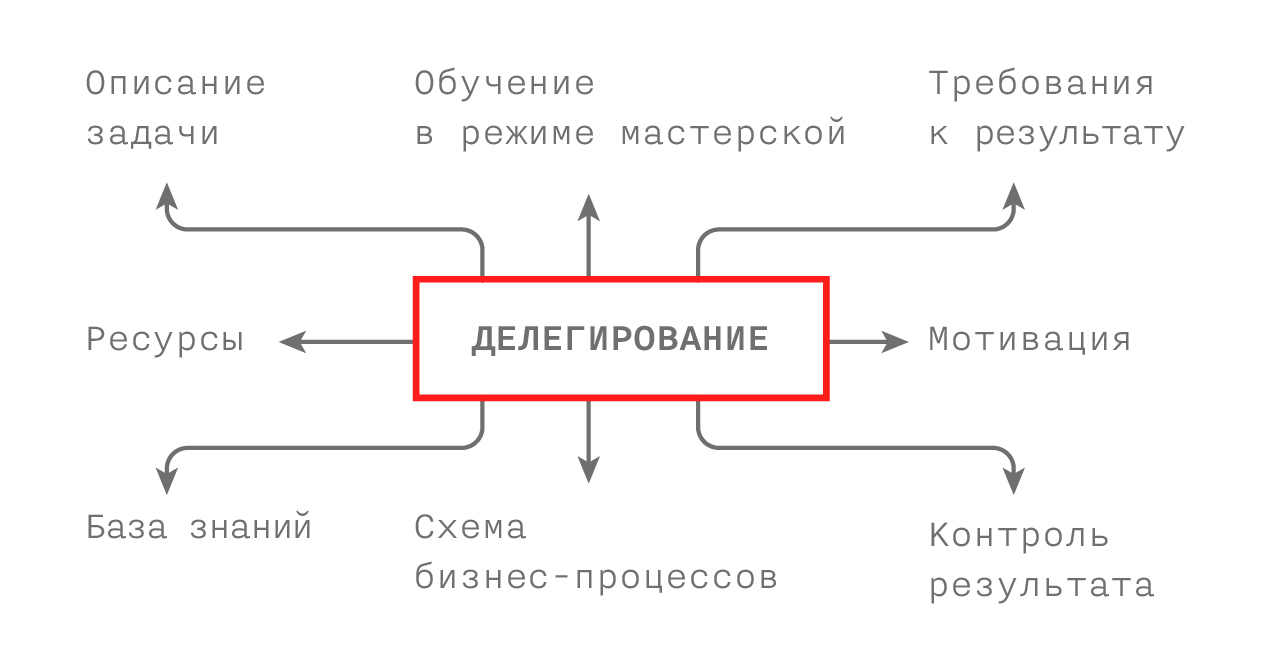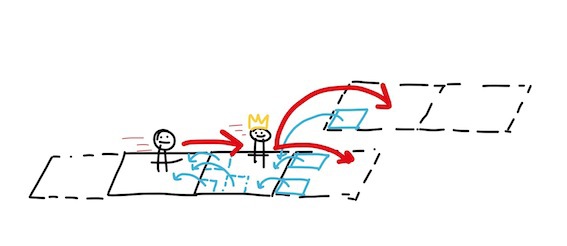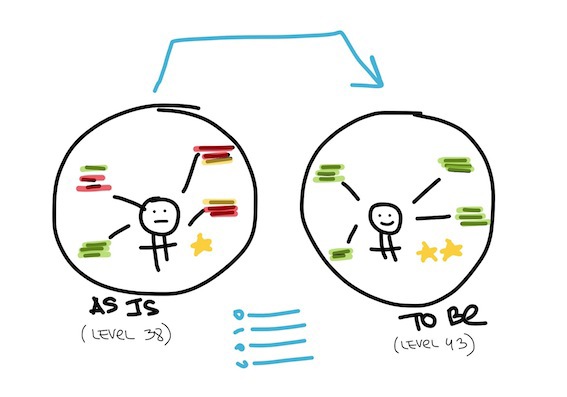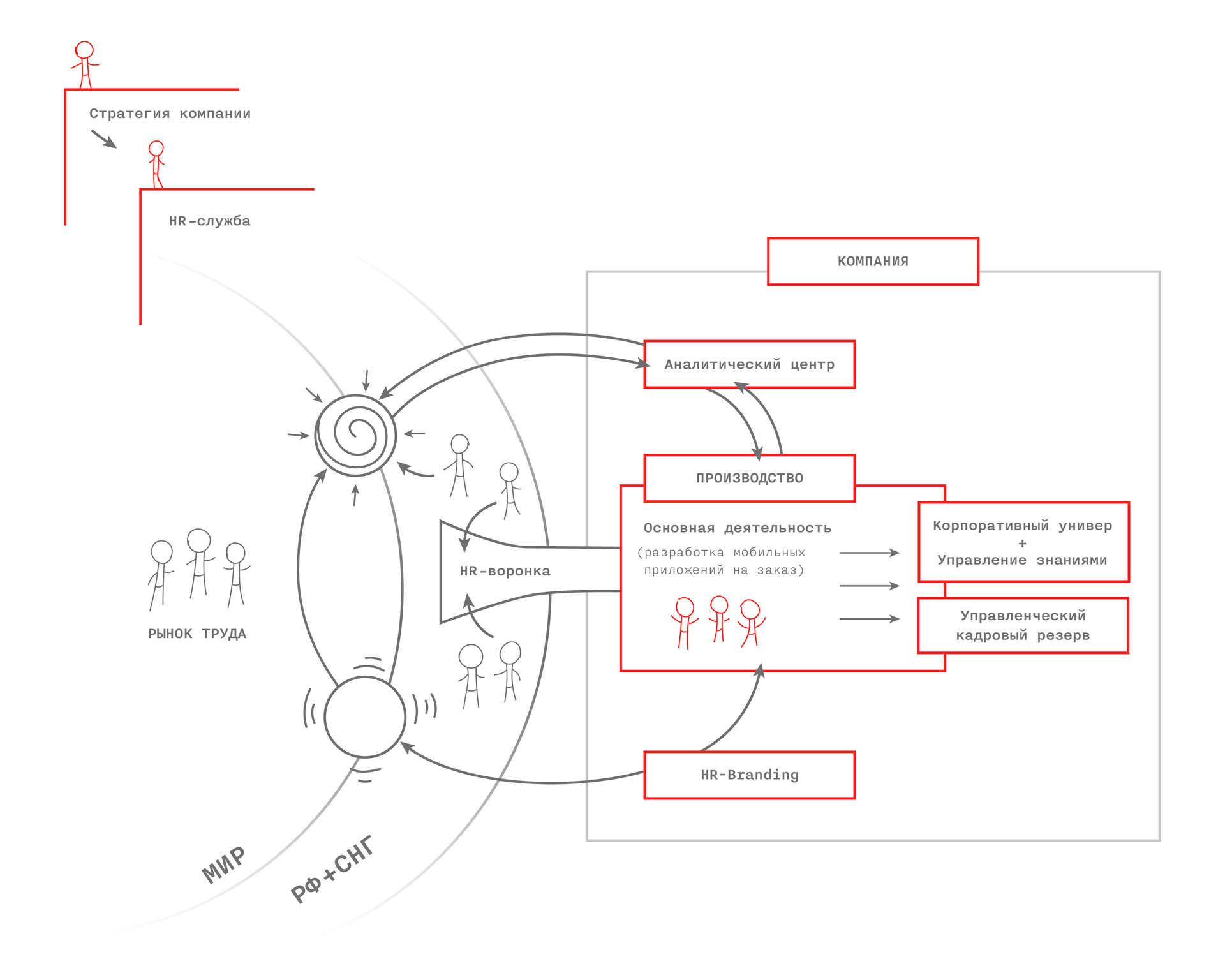Delegation: personal experience

Any business, any large-scale project relies primarily on the team, therefore, delegation of authority is one of the necessary tools for building a well-functioning system that gives a positive result at the exit. Design business processes, create a knowledge base, find the right and suitable people, put them in “their” place, give them the opportunity to open up and grow, help more at the start and come to control key indicators with less participation afterwards, here they are - components of the system .
Max Voloshin (@willie), Development Director of Redmadrobot, talks about the general principles of delegation and practices within the company.
TASKS AND DELEGATION OPTIONS
Types of tasks and principles of distribution
All cases one way or another fit into three categories:
- I will do only
- I will do better than others
- Will do anybody
Despite the fact that many important matters cannot be entrusted to anyone, in fact, almost all of them can be delegated. For cases that can make anyone , rather "a simple script," and they should be passed first. This may be the purchase of something, the transfer of documents (the courier service will cope) or the search for some information on the Internet (the office manager or the online assistant will cope).
Things that you do better than others will require a more detailed description during the transfer (proven algorithms, knowledge base) with mandatory training in the workshop format to develop the skill. Such cases are transferable, but this takes significantly more time.
Well, things that at first glance can only be done by youoften just seem so. Absolutely, some of them can be transferred in exactly the same way as in the case of affairs that you do better than others. This can be the management of a department or even the whole company: it just takes much more time to delegate such matters to train a potential leader, or to search and test people who already have a full range of necessary skills.
NB! What is not worth delegating?
It’s quite dangerous to delegate work with investors, develop your personal strategy or have dinner with a girl / wife in a restaurant - you really need to do such things yourself.
Delegation of individual tasks
Where to start when you decide to delegate a task to someone? First of all, you need to ask yourself the question “Will this person cope with the task?” And give an affirmative answer to it. Next, you need to observe 4 points:
- A clear description of the task and the requirement for the result. It is important that the task is understood not only by the delegate, but also by the delegate of the task. This must be verified, for example, by asking a person to describe in his own words how he understood the task: he outlined the steps necessary for its implementation, the desired result and the criteria for evaluating the success of this result.
- Availability of resources to complete the task. The result must be achievable: you need to make sure that the person has enough time, material and other resources to complete the task, or that he knows where and how to get them.
- An explanation of the relevance of the task. It is necessary to briefly explain why the task is needed and what problems it solves. This affects the person’s motivation and the quality of his task, because if you understand the goals, you can offer the best solution that you may not see.
- Control of the result. The date, time and place of control over the implementation of the result are clearly specified. This can be either an intermediate result or a complete completion of a task.
Delegation of task groups (authority)
Here, for illustration, the metaphor about the plane from the book "One-minute Manager and Monkeys" by Kenneth Blanchard is well suited . A long preparatory process is preceded by raising the aircraft into the air: it must be taken out of the hangar, refueled, done an external maintenance, prepare a route, check the systems, coordinate everything with the dispatchers, and finally go through the most intense take-off process! In general, this is not a simple matter. But then, after entering the course and level flight, everything happens almost automatically: you just need to look at the instruments and at the co-pilot who leads the plane.
If you put it on a practical plane, it turns out that before you delegate to someone a group of tasks (for example, a project), managing a department or even an entire company, you must first develop all the necessary business processes, equip them with a knowledge base and, most of all it’s important to educate a person to use all this and let him go only after there is confidence that he will cope. This is how to teach someone to ride a bicycle - you must first tell the principle, then set an example, then support for the saddle several times. And that’s it: a person is not very confident, but begins to ride. Otherwise, you can “break all the knees” and generally forever refuse “riding a hated bike”:
- Circuit diagram. It is always a top-level schematic representation of what is to be done in the universal language of graphic images. It is necessary to describe schematically what the delegated group consists of. This may be a project implementation plan with blocks of tasks arranged in the desired sequence. If department management is delegated, then a functional structure and organizational structure should be designed.
- The scheme of business processes. Inside the functional blocks, as well as between them and external blocks, there are connections through which the interaction takes place. All such interactions should be described. The degree of detail depends on the particular case - from the principles formulated in one sentence to detailed algorithms and procedures.
- Knowledge base. To move through business processes, you need materials. These can be plans, memos, templates, articles, books, training materials. In general, everything that will not only help a new person to plunge, but will also be used by him in his main work.
- Workshop training. First, the “master” does, and the student looks. Then they do it together. Then the student does, and the "master" looks. In order for the training to be effective, we just need a scheme, a description of the processes and a primary knowledge base.
These 4 points can also be completed externally, but then you need a person who will do all this for you or for you. And he will come up with, and describe, and put people and train. Such a path is quite real, but this does not mean that you have relieved yourself of your responsibility - just the opposite, now you need to figure out how to control what you do not understand. There may be the following way:
- Objective KPI Activities
- Verification of the achievement plan, which a person must do himself (verification with the help of experts, common sense)
- Short iterations to verify KPI exit and plan progress
5 PRINCIPLES
OF
DELEGATION 1. Delegation is an instrument of employee motivation and growth. There is a general principle: in order to grow, you need to leave your comfort zone. On the one hand, this means that you need to give more of your work to subordinates so that you have more time for new projects. For employees, this means that they have the opportunity to go beyond their usual and understandable tasks, to take part of your business, thereby approaching the next level of professional development. It is critical that both parties understand this the same way.
Delegation is not just a redistribution of tasks, but also a powerful element of professional development, which makes it possible to move forward for both the employee and his manager.

To do this, you need to clearly understand where the employee is now, where he wants to come, and what he will be given the fulfillment of delegated tasks in the format of personal development. The employee himself does not always have such an understanding, therefore the task of the leader is to help him by drawing up a development plan and describing the criteria for the transition between professional levels.
NB! It is imperative to provide a platform for frequent victories (read - motivation): to design the work of a subordinate so that big tasks are decomposed and tangible. It’s like in good arcade games - no matter what the player does, he accumulates points, opens achievements, bonuses are formed. That is, the game holds, fuels dopamine. It turns out such HR-gamification.

2. Be a cool teacher
The goal is to be able to delegate authority in order not only to transfer one task, but, for example, to transfer control to a department or a large project. Basic principles:
- Work in workshop mode. This was described in detail above in the example with a bicycle. This is not the only delegation system. There is a technique of a “Tibetan monastery”, when a person must go the same way on his own. As part of the fast-growing IT business, achieving results is also necessary quickly, and work in the workshop mode is therefore the best option.
- Feedback. Feedback on the results and reports that a person sends is extremely important. He must understand that he does the job not for show, that it is really needed. And to say thanks for the work done is generally a good tone. The recognition is a powerful addition to the ruble or the dollar. Criticism must be constructive and necessarily justified.
- Justice. The sense of justice is the most sensitive. Double standards reduce credibility.
- Adult-adult. Training is, first of all, cooperation, when one person transfers experience and another takes away, paying for it by performing work of a different level. This is a system of relations of adults in which there is no place for the moralizing of “parents” and the whims of “children”. It is necessary to agree on this format “on the shore”.
3. A thorough check of people at the entrance.
Choosing the right employee, partner or contractor before starting an interaction is more important than subsequent work with him. It seems to be obvious, but here a lot of mistakes just happen, which then lead to trouble. For example, there are such types of people:
- Viral rotten eggs. People who, through their negativity or disbelief in success, begin to poison others. They not only slow down development, but can even jeopardize the entire project. These must be disposed of quickly and ruthlessly.
- Slowed bombs. Everything seems to be OK, but a person sometimes breaks down in trifles, and then quickly takes control of himself. Such calls appear more often and at some point a person either disappears, or quits, or comes with a gun to shoot everyone.
- Black holes. When it is not clear why a person needs all this, where he is going, what he wants to achieve. There are two options: he really doesn’t know or hides, being in this case a “time bomb”, but in any case you get a person with a head in which there is a black hole, and you don’t know how you can synchronize the path with him. Such people can be very talented, but it’s important to understand that you take the risk: at any moment such a person may disappear, and you will not be able to predict this.
- Great guys. They are great, it’s nice to talk to them, they can tell you a lot about surfing, wakeboarding, nice cafes, cheapness and Thailand ... But they don’t know how and don’t want to work. They only want to spend time idly.
NB! Hiring employees in a team can only be delegated if you know how the hiring system works and make sure that the decisions on the acceptance and quality of candidates that the system issues are correct, as well as the competence of the team that serves this system.
4. Communication contract
When you start interacting with someone, you, as with the purchase of goods and services, need to conclude a contract, only a communication one. The pre-agreed principles of communication will save you from surprise when a person, for example, will not pick up the phone if you call him at 21.00. The basic principles are as follows:
- Communication schedule. When someone is available, when you can call, and when not to. Is it possible to do something on the weekend or late at night when email is checked and so on.
- Reaction time and format. It is necessary to clearly agree on how long the response to the letter, SMS or call will be. For example, a letter should be answered in no more than 24 hours, or the response should be rescheduled for another time within 2-3 hours. If there is no way to answer an incoming call, after what time do you call back or send SMS with further actions.
- Problems for discussion should be described and analyzed before possible solutions. It is necessary to agree to set forth the problems in writing and correctly: with a normal wording, background, solution options, your own version and arguments. Very often this very action removes the problem, and the person does not need to come with it, he can solve everything himself.
- Changes in conditions should become known in advance, and not at the moment. If the meeting is canceled or the task is not solved in full, this should be notified in advance so that the other person can change their plans, and not lose time. Or so that you can form another solution: for example, discussing a draft or transferring the full result to a more convenient time for everyone.
- Features of styles. Everyone has their own speed of presentation of thoughts and the form of this presentation. It is necessary to agree on common things at the starting stage, and also to indicate that the problem points will not be left unattended in the future, and an appropriate correction will be made. Many, for example, cannot communicate productively when someone speaks in a raised voice or uses a mat in speech.
NB! The main danger that arises in the process of delegation is to entrust a person with such a volume of tasks that he is unable to cope with. This lowers his motivation and leads to poor results. A comfortable volume of tasks can be identified only experimentally, simultaneously making adjustments. If an employee copes with the volume entrusted to him and is satisfied with his work, this allows him to do more in the future.
5. Control system
Well, all the individual tasks have been transferred, the authority for the projects and groups has been delegated, but the responsibility is still on you. Here you can not do without a control system. For each, she will be her own, but the principles remain the same:
- Calendar of arrangements. The form can be organized as you like: in the form of notes in the electronic calendar, tasks with reminders or in a regular paper diary. The most important thing is to fix the date and the task performer, so that you see this information on the right day.
- Insurance. If you need to learn about the results not from newspapers or monthly reports, or if you doubt that the exact result you need will be obtained, you can use three types of insurance:
- Agree that the contractor receives approval of the result on your part before he goes “ to work. ”
- At the moment when the result has gone to work, you are informed by CMS, by letter or otherwise.
- If “something went wrong”, and there was a deviation from the plan, a notification is sent. Here you can adjust the scope in advance, for example, notify only if the budget or deadlines deviated by more than 10% of the planned. - Reporting by the president. Reporting must be set up in such a way that, having received 5 pages, you should immediately understand what is happening in your “diocese”, and if you wish, to detail. This means that you need to design the form and content of the reports yourself, you cannot delegate this work to anyone.
- Communication with the team. It is also necessary to communicate informally with your team, on which the results depend, and the people who hold task groups or projects, in order to be on the wave. It is very advisable to do this in person, or at least not by mail (Skype or phone will work better).
- Refresh format and algorithm. Well, yes: you need to periodically review how your system works. Notes that can be left in case of emergency situations, and once every 1-3-6 months, collect them and make changes are very suitable. Well, or you can make changes immediately, as the Japanese do: a classic example is TPS (Toyota Production System) .
CASE 1: DELEGATION OF THE HR AUTHORITY GROUP

Max Voloshin:
“Some time ago, I faced the need to delegate an HR system, which until then I had been doing myself. I started by studying the subject area: I had to test a number of hypotheses.
I depicted for myself the HR system of the company in the form of a diagram with blocks. Within each block, he painted a business process: what should be at the input, what happens in the process, what needs to be received at the output.
The process of hiring new employees, for example, includes several stages: first, requirements for vacancies are developed, resources for their publication are selected, and an allocation algorithm is thought out. I painted all these stages in detail and made templates: job descriptions, test tasks and answers to potential applicants. In the latter, different scenarios have been worked out: the candidate is suitable, the candidate may be suitable or the candidate is not suitable at all.
Before starting to delegate the HR system, I myself plunged deeply into this work: an understanding was formed of how and when it is better to carry it out, and then it turned into a plan. In the morning, I scooped up the mail, looked at all the responses, categorized them and then answered people (using templates). I already understood the points to which special attention should be paid. When it came time to delegate the tasks to the HR manager of Redmadrobot, I began to act in batches, applying the existing experience. We held several workshops, where I step-by-step explained to the manager the essence of the work: we opened the responses, I showed how to read the resume correctly, explained why I decide to enter the resume into the system and so on. ”
CASE 2: DELEGATION OF THE PROJECT IN THE QA DEPARTMENT

Ilya Gorshkov, Head of QA Redmadrobot:
“For each year, the QA department has a work plan, it clearly defines the functional responsibilities of different levels and the reporting structure: it is clear from the outset what types of tasks each QA engineer will have to perform. Delegation also falls into the category of functional responsibilities.
The work is initially divided into 2 large groups: directly testing and development of test cases. This is delegated to two different employees. In addition, all employees have a personal development plan: when a person can “lead” new areas for him, when he receives new responsibilities and changes his position.
If there is a business that I can do myself, but I see that some of the employees need to develop in the appropriate direction, I transfer the task to him. So it was with our project of the Otkritie mobile bank, the responsibility for which I was delegated to the QA engineer.
How did this happen? First of all, I informed the team of project managers that the new person was responsible for the project. Then he uploaded the QA project plan and reporting system to the employee for project managers and customers. It was further agreed on what resources can be expected in the framework of this project. If at some point these resources were not enough to complete the tasks, then the employee contacted me and received an additional resource - we also agreed on this process in advance. The decision-making process for the project was divided into 2 levels: on the first, a person could make decisions on his own, on the second, higher, he connected me. The insurance system was also developed through the connection of project managers, and in the last instance, the production director. ”
A lot of factors influence the time spent on delegation: cognitive data of a person, degree of readiness of the system for transfer, scope tasks. To make the process as quick and efficient as possible, you need to have a concrete action plan on hand and be patient: at the initial stage, temporary and monetary investments in a person are large, but in the future, the efforts spent should bring a tangible positive effect. But in no case should we forget: the delegation of the task does not relieve responsibility for the result from the person who delegated it.
Sources and Further
Reading Books:
“Delegation and Management,” Brian Tracy
“One-Minute Manager and Monkeys,” Kenneth Blanchard
Articles:
“How to Delegate”
“How to Set Tasks”
Audio Podcast:
“50 Delegation Stickers,” Sergey Potapov
